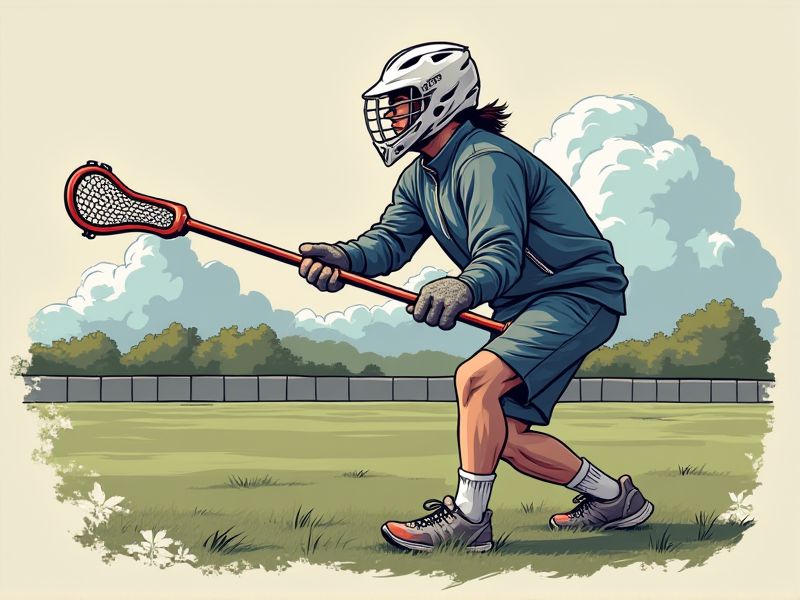
Kevin Leveille emphasizes the importance of balancing physical speed with mental composure in lacrosse, advising players to "be fast on the field physically, but play slow mentally. Basically, play hard but play smart" . This approach suggests that while physical agility is crucial, strategic thinking and decision-making are equally vital for success in the game. By adopting this mindset, players can improve their performance by making more effective decisions during fast-paced gameplay. Effective lacrosse players must combine physical prowess with mental discipline to outmaneuver opponents and achieve victory.
How to Be Better at Lacrosse
Daily stick handling drills
Consistent daily stick handling drills build the muscle memory necessary for quick, precise movements on the field. Practicing these drills every day enhances hand-eye coordination and ensures smoother transitions during gameplay. Maintaining a disciplined routine not only boosts confidence but also leads to measurable improvements in your overall lacrosse performance. Over time, integrating these drills into your practice regimen will allow you to anticipate and react more effectively during competitive situations.
Consistent endurance training
Integrating consistent endurance training enhances cardiovascular efficiency, leading to sustained high-intensity performance during lacrosse games. This increased stamina reduces recovery time between sprints and complex plays, thereby maintaining competitiveness throughout gameplay. Scientific studies confirm that athletes who commit to regular endurance workouts experience improved oxygen utilization and lower lactate levels, factors that contribute directly to better agility and speed. In turn, this physical resilience creates a positive feedback loop where enhanced endurance translates into fewer fatigue-induced mistakes and increased overall performance on the field.
Agility and footwork development
Enhancing lacrosse performance starts with drills that boost dynamic balance and rapid directional changes, directly improving agility and footwork. Incorporating ladder drills and cone exercises into your training routine consistently trains your body for quick, multi-directional movements. Focusing on plyometric exercises further builds explosive power that translates into speed and precision on the field. As you refine these skills, expect to see an improvement in your capability to dodge defenders and maintain tight control during fast-paced transitions.
Strength and conditioning workouts
Incorporating targeted strength and conditioning workouts directly improves lacrosse performance by boosting overall power and agility. Integrating compound resistance exercises and plyometric drills increases muscle coordination and explosiveness on the field. Structured regimens not only enhance endurance but also reduce fatigue during extended play, leading to consistent energy output. Data-driven training programs have shown that progressive overload methodologies result in measurable improvements in speed, strength, and reaction time in competitive athletes.
Game strategy analysis
Effective lacrosse improvement begins by breaking down game footage to identify strengths and opportunities for attack or defense adjustments. Detailed strategy analysis helps you recognize patterns that can be exploited, thus directly impacting your decision-making during high-pressure moments. By conducting targeted drills that replicate game scenarios, you'll see a measurable increase in both individual skills and team coordination. This data-driven approach creates a cycle where refined strategy leads to enhanced performance, which in turn opens up even more opportunities for tactical advancement.
Effective team communication
Effective team communication is essential in lacrosse because it aligns teammates with strategy and bolsters collective performance. Clear, concise instructions during practice and games reduce the likelihood of errors and ensure that all players understand their roles in fast-paced situations. Data indicates that teams focusing on structured communication can see performance improvements of up to 20%, as they are better prepared to adjust tactics on the fly. Regular communication drills and debrief sessions build trust and accountability, ultimately fostering a more cohesive and responsive team on the field.
Rapid decision-making drills
Rapid decision-making drills are a game-changer for lacrosse athletes, as they simulate the intensity of real-match scenarios and enhance on-field cognitive agility. These drills often involve unpredictable ball feeds, simulated defensive movements, and rapid transition plays, which force players to make quick decisions under pressure. Data from performance studies indicates that athletes who regularly engage in such drills exhibit up to a 20% improvement in reaction times during competitive play. Consistently integrating rapid decision-making exercises into your training routine builds both mental and physical resilience, ultimately providing a decisive competitive edge.
Mental focus and resilience training
Improving lacrosse performance starts with sharpening your mental focus by integrating mindfulness exercises into your training routine. Developing resilience through structured mental conditioning allows you to maintain composure during high-stakes scenarios on the field. Emphasizing structured routines and visualization techniques can help transform stress into a competitive edge, enhancing your overall performance. Consistent practice in these areas builds mental toughness, ultimately leading to better decision-making and a higher level of play.
Comprehensive recovery routines
Comprehensive recovery routines optimize performance by reducing fatigue and preventing injuries, which directly benefits your on-field agility and endurance. Prioritizing proper hydration, balanced nutrition, and quality sleep creates a strong foundation for muscle repair and overall energy restoration after intense lacrosse practices. Integrating active recovery methods--such as low-impact workouts, stretching, foam rolling, or even contrast baths--helps alleviate muscle soreness and maintains flexibility. Additionally, adopting recovery strategies that include mental relaxation techniques enables you to stay focused and resilient, ultimately boosting your lacrosse skills and consistency during game play.
Proactive coach feedback integration
Listening actively to coach feedback boosts your lacrosse skills by pinpointing specific areas for improvement. Integrating that guidance into your daily drills helps create tailored practice sessions that enhance both technique and decision-making. When you reflect on this feedback and adjust your style, you cultivate a foundation for long-term athletic development. Consistently applying these insights forms a proactive loop, ensuring your progress mirrors the evolving demands of the game.
Summary
Daily stick handling drills build crucial muscle memory, leading to more precise ball control during high-pressure scenarios. Consistent endurance training enhances cardiovascular health, directly translating into sustained performance throughout long matches. Focused agility and footwork development enable quicker directional changes, providing a competitive edge in both offense and defense. Together, these practices form a holistic regimen that markedly improves lacrosse performance through enhanced coordination, stamina, and rapid movement.
